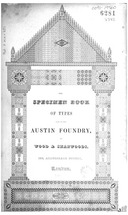Reed (p. 359-360) notes that Richard Austin started as a punchcutter for Simeon & Charles Stephenson about 1795. S. & C. Stephenson ceased trading in 1799; between then and starting his own foundry circa 1815 he was apparently a freelance punchcutter. Reed notes that he cut "most of the modern founts" for both William Miller (Edinburgh) and Alexander Wilson (Glasgow) Moseley et. al. (p. 26) give addresses for him in London in 1790 and 1799-1805.
He started his own foundry about 1815. He died in 1824. At that point his son George Austin succeeded to the business, under the name Austin & Sons, using the foundry name "Imperial Letter Foundry."
Neither Reed nor Gray give George Austin's date of death. Upon his death, the foundry was purchased by R. M. Wood (Moseley et. al. identify him as Richard Mason Wood), who entered into a partnership with Samuel and Thomas Sharwood. This must have been prior to 1839, when they issued their first specimen.
R. M. Wood and Samuel & Thomas Sharwood styled their foundry the "Austin Letter Foundry." Founder's London A-Z (p. 11) reproduces a drawing from Tallis. London Street Views (1838-1840) which shows "Wood and Sharwood's Austin Letter Foundry"
R. M. Wood had at least four sons (this is important later): J. Wood, R. [M.?] Wood, Austin Wood, and Rowland Wood. (Reed, and also Gray).
R. M. Wood died 1845. None of Wood's four sons were taken into the firm direclty at that time. The firm continued as S. & T. Sharwood (still styled the Austin Letter Foundry). (Reed 360)
Reed recounts their publication in 1854 of a specimen of "Polytyped Metal Ornaments." These acquired from Vizitelly, Branston & Co.; see Reed for details.
Now things get a bit confusing...
Reed simply says that circa 1856 on the death of the partners the contents were auctioned in chancery and "dispersed to the trade." Moseley et. al. further note that "some of it" went to "R. M. Wood's sons, J. & R. M. Wood" who continued it. ({ Nicolette Gray (p. 110 of the 1938 edition)} says "J. and R. Wood (not "R.M. Wood"), but I'm sure that R. Wood had a middle name.)
Nicollete Gray does the best job I've read so far in sorting out the end of this foundry. She says that J. and R. Wood moved it (first to West Smithfield and then to Farringdon Road; Moseley et. al. in Founder's London A-Z (p. 10) confirm this).
They seem to have sold off the "principal modern jobbing founts" to Miller & Richard in 1863. At that have been trading as "Wood & Sharwood" (or at least that's who Miller & Richard said they bought these founts from)
Then in 1872 they sold out entirely to Figgins. At the end they seem to have been trading as the "Austin Letter Foundry," J. & R. Wood.
The Austin Letter Foundry of R. M. Wood's two sons, J. & R. Wood, begun by Richard Austin in 1815 and sold to Figgins in 1872, should not be confused with the Austin Letter Foundry of R. M. Wood's other two sons, Austin and Rowland Wood , which was an entirely separate concern.
Reed, Talbot Baines. A History of the Old English Letter Foundries. London: Elliot Stock, 1887.

1838. Specimen Book of Types
The Specimen Book of Types Cast at the Austin Foundry, by Wood & Sharwoods . (London: Wood & Sharwoods, 1838). This volume has been digitized by Google from the Bibliothèqe de Catalogne copy. The icon here links to a local version of the Google Books scan.
The specimen book digitized by Google and its reprint here are in the public domain.
All portions of this document not noted otherwise are Copyright © 2011 by David M. MacMillan and Rollande Krandall.
Circuitous Root is a Registered Trademark of David M. MacMillan and Rollande Krandall.
This work is licensed under the Creative Commons "Attribution - ShareAlike" license. See http://creativecommons.org/licenses/by-sa/3.0/ for its terms.
Presented originally by Circuitous Root®
Select Resolution: 0 [other resolutions temporarily disabled due to lack of disk space]